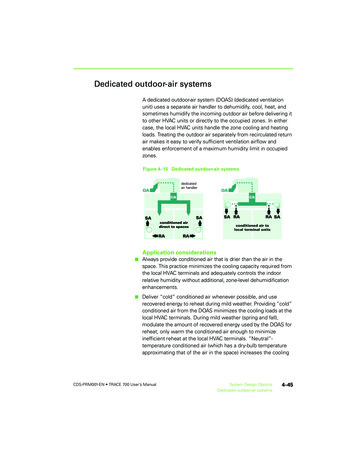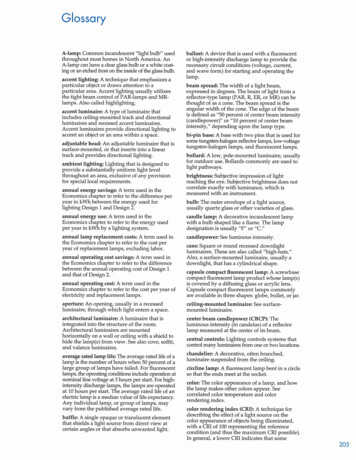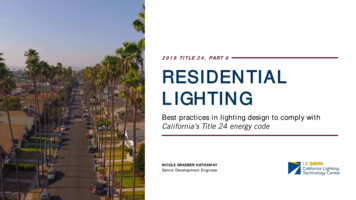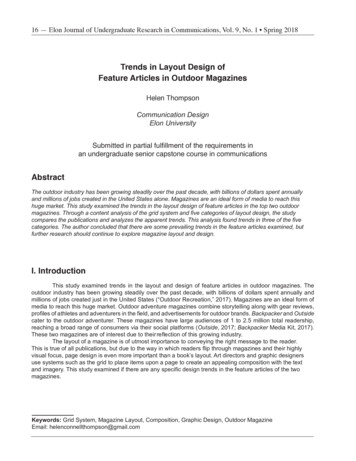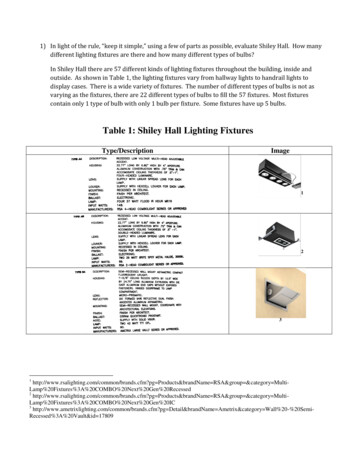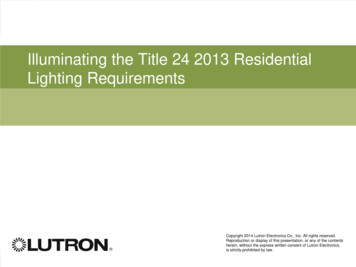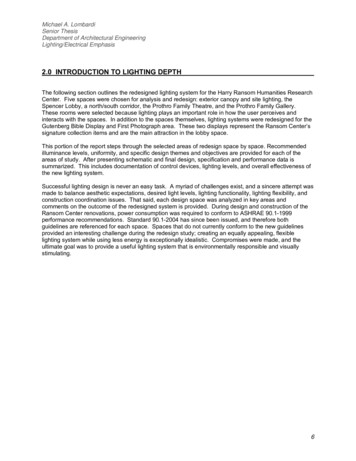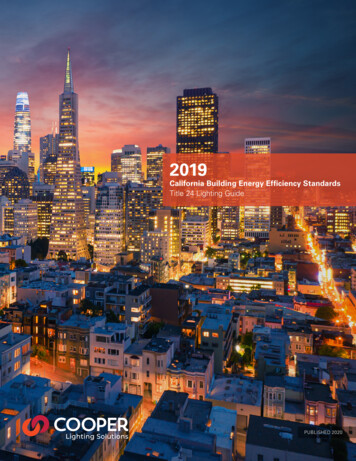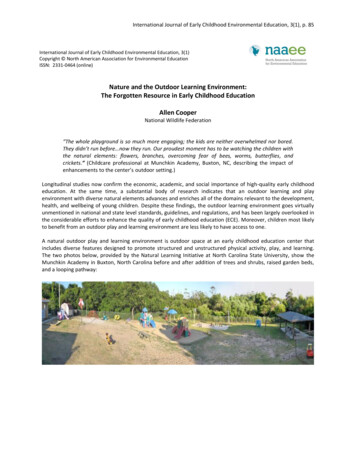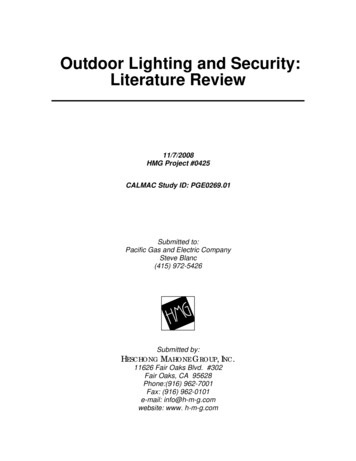
Transcription
Outdoor Lighting and Security:Literature Review11/7/2008HMG Project #0425CALMAC Study ID: PGE0269.01Submitted to:Pacific Gas and Electric CompanySteve Blanc(415) 972-5426Submitted by:HESCHONG MAHONE GROUP, INC.11626 Fair Oaks Blvd. #302Fair Oaks, CA 95628Phone:(916) 962-7001Fax: (916) 962-0101e-mail: info@h-m-g.comwebsite: www. h-m-g.com
PACIFIC GAS AND ELECTRIC COMPANYOUTDOOR LIGHTING AND SECURITYTABLE OF CONTENTSExecutive Summary . 1Introduction. 2Questions. 2Background – Outdoor Lighting Standards and Energy Use . 3California Standards . 3Title 24 “Security Lighting” Provisions . 4Why Street Lighting is Included in this Review. 4Recent Growth in Commercial Outdoor Lighting . 4Background – Times and Places at which Crimes are Committed . 5Time at Which Crimes are Committed. 5Places at Which Violent Crimes are Committed . 6Literature Review . 8Method of Review . 8Research Issues. 9Models of Criminal Behavior . 9Displacement vs. Diffusion of Benefits . 9Experimental Controls and Level of Significance. 10Confounds . 10Study Populations . 11Types of Crime . 11Photometry . 11Previous Literature Reviews. 12Clark (2002) . 12Eck (1997) . 14IES (2003) . 14Reviewed Papers . 15Atkins, Husain and Story (1985) . 16Boyce and Bruno (1999) . 16Boyce et al. (2000) . 17Boyce et al. (2001) . 18
OUTDOOR LIGHTING AND SECURITYPACIFIC GAS AND ELECTRIC COMPANYClark (2003) . 18Hendricks et al. (1999) . 21OSHA (1998) . 22Painter (1997) . 23Painter 1999. 24Quinet and Nunn (1998). 25Conclusions. 26General Conclusions . 26Insufficient Statistical Power. 26Significant Results are Likely to be False Positives . 26Extensive Confounds in the Experimental Data. 27Most Places have no Crime. 27Displacement Effects Observed, but not very Certain . 27Little Theoretical Basis for Why Lighting would affect Crime . 27Higher Illuminances Reduce the Fear of Crime . 27Illuminance from Outdoor Lighting aids in the Recognition of Objects andFaces. 28Higher Illuminances May Improve Professional Surveillance . 28Lighting May Encourage Behaviors that Lead to Crime . 28Special Lighting No Longer Required for CCTV . 28Alternatives to Lighting . 29Specific Conclusions. 29Does the presence of nighttime lighting around commercial and residentialbuildings, parking lots and walkways influence the fear of crime?. 29Does the presence of nighttime lighting around commercial and residentialbuildings, parking lots and walkways influence crime?. 29Does the quantity or quality of nighttime lighting influence crime? . 29Does the quantity or quality of nighttime lighting influence the fear of crime?. 29Is there a causal relationship between nighttime lighting and crime? . 30Bibliography . 31Acknowledgments . 35
PACIFIC GAS AND ELECTRIC COMPANYOUTDOOR LIGHTING AND SECURITYTABLE OF FIGURESFigure 1 – Title 24 multipliers for lighting power density for “special securityrequirements” (TABLE 147-D). 4Figure 2 – Percentage of All Crimes Committed by Hour of the Day, LondonBorough of Harrow 6Figure 3 – Times at Which Crimes are Committed 6Figure 4 – Locations at Which Violent Crimes are Committed 7Figure 5 – Customer Responses to Three Gas Station Canopy LightingInstallations 18Figure 6 – UCR Crime Rate and Upward Light Energy Loss in USA Cities (fromClark 2003), showing no correlation between lighting density andcrime 20Figure 7 - UCR Crime and Upward Light Energy Loss per Person in USA Cities(from Clark 2003) 21Figure 8 – Rates of Homicide for Various Retail Industries (NIOSH, 1996). 23Figure 9 – Prevalence of Crime Before and After Relighting, Dudley 23Figure 10 - Prevalence and Incidence of Crime Before and After Relighting,Stoke 25
PACIFIC GAS AND ELECTRIC COMPANYOUTDOOR LIGHTING AND SECURITYExecutive SummaryThis literature review is intended to inform Pacific Gas and Electric Company (PG&E)about the existing research literature relating to any relationship between night-timeoutdoor lighting and security. This report reviews ten original research papers and threeprevious literature reviews. It sets out to answer the following questions:1. Does the presence of nighttime lighting around commercial and residentialbuildings, parking lots and walkways influence crime or the fear of crime?2. Does the quantity or quality of nighttime lighting influence crime or the fear ofcrime?3. Is there a causal relationship between nighttime lighting and crime or the fear ofcrime?None of the papers reviewed presents sufficient evidence to demonstrate a causal linkbetween night-time lighting and crime. The available results show a mixed picture ofpositive and negative effects of lighting on crime, most of which are not statisticallysignificant. This suggests either that there is no link between lighting and crime, or thatany link is too subtle or complex to have been evident in the data, given the limited sizeof the studies undertaken.Several studies showed a significant relationship between lighting and the fear of crime,i.e. that people feel safer in lit areas. The amount of light required to reduce the fear ofcrime appears to be in the range of 10 horizontal lux (1 footcandle), with little increase inperceived safety above that level.1Heschong Mahone Group, Inc.
OUTDOOR LIGHTING AND SECURITYPACIFIC GAS AND ELECTRIC COMPANYIntroductionThis literature review is intended to inform Pacific Gas and Electric Company (PG&E)about the existing research literature relating to any relationship between night-timeoutdoor lighting and security. PG&E supports the California Energy Commission in itsresponsibility for setting requirements for outdoor lighting in California; theserequirements may include but are not limited to maximum wattage, maximum lightingpower density, and allowable control options.Throughout the review we will use the term “night-time lighting” instead of “securitylighting” because the latter presupposes a link between lighting and security. We alsodiscuss “crime” or “fear of crime” rather than “security”. “Security” is a rather broad andloosely defined term, which can include both specific steps taken to prevent danger orinjury, along with the psychological state avoiding anxiety or fear. The first twodefinitions offered in Merriam Webster’s dictionary are most applicable here:Security: 1: the quality or state of being secure, as a freedom from danger. 2:freedom from fear or anxiety.Wordnet from Princeton University offers further definitions:Security: freedom from anxiety or fear; "the watch dog gave her a feeling of security"Security: the state of being free from danger or injury; "we support the armedservices in the name of national security".The available literature that we reviewed did not address the broader term “security” perse, but rather the more specific topics of crime, and/or fear of crime. “Crime” is typicallytaken to be publicly reported events, thus a neutral source of data for the study wasavailable for analysis. “Fear of Crime” is typically based on respondents’ perceptionsrecorded during study interviews.Further more, we do not report on studies of the relationship between accidents, such astrips and falls, or vehicular accidents, as that literature relates more to specific taskvisibility and risk of physical hazards, rather than more general purpose nighttimelighting intended to produce a sense of security.QuestionsThis literature review set out to answer the following questions:4. Does the presence of nighttime lighting around commercial and residentialbuildings, parking lots and walkways influence crime or the fear of crime?5. Does the quantity or quality of nighttime lighting influence crime or the fear ofcrime?6. Is there a causal relationship between nighttime lighting and crime or the fear ofcrime?Heschong Mahone Group, Inc.2
PACIFIC GAS AND ELECTRIC COMPANYOUTDOOR LIGHTING AND SECURITYBackground – Outdoor Lighting Standards and Energy UseArguments have been made both for and against outdoor lighting for a wide variety ofreasons. The most common arguments in favor of outdoor lighting are to preventaccidents (both vehicular accidents, and trips and falls), and to reduce crime and/or thefear of crime. Social factors such as encouraging retail purchasing, and bringing peopleout on to the streets have also been put forward. The most common arguments againstoutdoor lighting are the increase in electricity use the creation of “light pollution” thatobscures the view of night sky and may have a variety of adverse ecologicalconsequences (Rich and Longcore 2005). Other factors such as “light trespass” (or“obtrusive light” providing unwanted light in areas beyond the immediate lit property)and a probable link between night-time light and the formation of cancers have also beenadvanced (Davis 2001, Baldwin et al 1998, Dauchy et al. 1997, Feychting et al. 1998)California StandardsIn response to the California energy crisis, on February 1, 2001 Governor Gray Davisissued Executive Order D-19-01 that required retail business to substantially reduceunnecessary outdoor lighting energy use during non-business hours.In April of 2001 the California Legislature and Governor Davis passed and signed SenateBill 5X. This bill established authority1 for the California Energy Commission to adoptlighting standards for outdoor lighting. The first round of Outdoor Lighting Standardswere adopted in the 2005 revision of California’s lighting standard (Title 242).The definition of outdoor lighting is taken from Title 24 2005 section 147, and includes:“all outdoor lighting, whether attached to buildings, poles, structures or selfsupporting, including but not limited to: hardscape areas including parking lots;lighting for building entrances; sales and non-sales canopies; lighting for all outdoorsales areas; and lighting for building facades.EXCEPTIONS to Section 147:1. Temporary outdoor lighting.2. Lighting required and regulated by the Federal Aviation Administration and theCoast Guard.3. Lighting for public streets, roadways, highways, and traffic signage lighting,including lighting for driveway entrances occurring in the public right-of-way.4. Lighting for sports and athletic fields, and children’s playgrounds.5. Lighting for industrial sites, including but not limited to, rail yards, maritimeshipyards and docks, piers and marinas, chemical and petroleum processing plants,and aviation facilities.6. Automated Teller Machine lighting.1This authority is established in the Public Resources Code section 25402.5 (3) (c)2Section 147(c)1B3Heschong Mahone Group, Inc.
OUTDOOR LIGHTING AND SECURITYPACIFIC GAS AND ELECTRIC COMPANY7. Lighting of public monuments.8. Internally illuminated, externally illuminated, and unfiltered signs.9. Lighting used in or around swimming pools, water features, or other locationssubject to Article 680 of the California Electrical Code.10. Lighting of tunnels, bridges, stairs, and ramps.11. Landscape lighting.”Title 24 “Security Lighting” ProvisionsThe issue of “security” lighting is of particular interest in California because Title 24allows designers to increase lighting power densities in areas with “special securityrequirements”. The multipliers are shown in Figure 1; this list is exhaustive, i.e. no otherplaces are allowed to be designated as having special security requirements. However,“security lighting” or “special security requirements” are not further defined orreferenced Title 24.FunctionMultiplierRetail parking lots in lighting zones 1, 2 and 31.25Hardscape areas within 100 feet of the entrance of senior housing facilities inlighting zones 1, 2, and 31.25Parking lots and walkways within 60 feet of entrances to the building for lawenforcement, fire, ambulance and emergency vehicle facilities2.00Figure 1 – Title 24 multipliers for lighting power density for “special security requirements”(TABLE 147-D).Why Street Lighting is Included in this ReviewThe definition of “outdoor lighting” covered in Title 24 specifically does not includestreet lighting, since the California Energy Commission does not have jurisdiction overthe energy use of public streets. Nevertheless, this review includes studies of streetlighting, because most published studies involving lighting and crime have been based onstreet lighting.Recent Growth in Commercial Outdoor LightingLawrence Berkeley Laboratory (2002) estimated that in 1999 commercial outdoorlighting accounted for 5 TWh of electricity consumption in California, or 2% of totalelectricity use (5.6% of commercial electricity use). This value was unchanged from the1997 figure given by the California Energy Commission (1998). The California OutdoorLighting Baseline Assessment (CEC 2003) found a slightly lower figure of 3.07 TWh forcommercial outdoor lighting energy use, with a peak demand of 809 MW in the winterbetween 7pm and 8pm.Heschong Mahone Group, Inc.4
PACIFIC GAS AND ELECTRIC COMPANYOUTDOOR LIGHTING AND SECURITYCEC 2004 estimates that security lighting represents about 47% of commercial outdoorlighting by wattage3; CEC 2003 estimates that the parking represents 31.5% of wattage,pedestrian and walkway lighting represents 22.4%, and specific “security” lighting only6.8%. These differing estimates likely reflect different definitions of security lighting,i.e., CEC 2004 may include parking lot and/or pedestrian lighting in its estimate.Although none of the reports cited gives information about whether outdoor lightingenergy use has increased or decreased over time, there is a widespread belief (evidencedby manufacturer’s literature and magazine articles) that commercial outdoor lighting hasexperienced rapid growth in recent years. According to the National ElectricalManufacturers’ Association, the market for “roadway”-style lighting fixtures is growingat 5-6% per year by value4.Background – Times and Places at which Crimes are CommittedLater in this report, the research evidence for links between lighting and crime isdiscussed. An important background to this discussion is to note two things: first that themajority of crime is committed during daylight, and so is unlikely to be influenced by thepresence of absence of electric lighting, and second that only a small percentage ofcrimes are committed in places that have (or could have) commercial outdoor lighting.These two pieces of information help to establish the potential magnitude of the effect ofoutdoor lighting on crime.Time at Which Crimes are CommittedData from the U.S. Department of Justice (1994) shows that a narrow majority of crimesare committed during the daytime (defined as 6 a.m. to 6 p.m. irrespective of season andlocation). Data specifically on urban crime by time of day is given by Spencer, Austinand Chainey (2001) for the London Borough of Harrow; this data shows that crime peaksat around 3 p.m. and remains high until around midnight.If lighting has an effect on crime because of the increased likelihood of the crime beingwitnessed by police or civilians, then this effect is most likely to occur during the period6 p.m. to midnight. This is the period during which people are most likely to be out inpublic spaces (both civilians and police are much less likely to be on the streets frommidnight to 6 a.m.).Note that the crimes that have the highest percentage of incidents from 6 p.m. to midnight(see below) are violent crimes against the person, so any effect due to outdoor lightingshould be most noticeable in the data on violent crime. Robbery (43% of all robberies are committed between 6 p.m. and midnight) Rape/sexual assault (37%)3 “Any parking lights or general area lighting which are operated on a separate meter would not beincluded. Consequently, we do not know very much about parking lighting in shopping centers or otherlarge complexes from this data.”4Bremer, D.The Latest in Transportation Project Lighting. Electrical Contractor Magazine July 2005.http://www.ecmag.com/editorial detail.aspx?id 17955Heschong Mahone Group, Inc.
OUTDOOR LIGHTING AND SECURITY PACIFIC GAS AND ELECTRIC COMPANYAssault (34%)Figure 2 – Percentage of All Crimes Committed by Hour of the Day, London Borough of HarrowDaytimeNighttimeNotknown6 a.m.6 p.m.6 p.m.midnightMidnight 6 a.m.Crimes of violence (9.8M crimes)52.2%34.4%11.7%1.6%Property crimes including motorvehicle theft (31M)37.1%15.1%14.0%33.7%Motor vehicle theft (1.8M)25.0%19.6%29.4%26%Figure 3 – Times at Which Crimes are Committed5Places at Which Violent Crimes are CommittedData from the U.S. Department of Justice (1994) shows that the percentage of violentcrimes committed in places that have commercial outdoor lighting is somewhere between8% and 19% (including all crimes committed in parking lots and garages, and someproportion of crimes committed in “parks”, “inside stations”, and “other”; crimescommitted on the street are excluded because they are under street lighting)5Adapted from U.S. Department of Justice, eschong Mahone Group, Inc.6
PACIFIC GAS AND ELECTRIC COMPANYOUTDOOR LIGHTING AND SECURITYLocation of crimePercentageof crimesAt or near respondent’s home14.4 %Near home8.3 %On the street near home3.2 %At, in, or near a friend’s, relative’s or neighbor’shome7.5 %Inside a restaurant, bar or nightclub4.9 %Inside another commercial building8.2 %Parking lot or garage7.7 %Inside a school building or on school property13.1 %In apartment yard, park, field or playground2.8 %On street other than near own home19.8 %On public transportation or inside station1.1 %Other8.9 %Figure 4 – Locations at Which Violent Crimes are Committed66Adapted from U.S. Department of Justice, schong Mahone Group, Inc.
OUTDOOR LIGHTING AND SECURITYPACIFIC GAS AND ELECTRIC COMPANYLiterature ReviewResearch on a possible link between lighting and crime began in earnest in the 1960s inthe US, following a dramatic rise in city-center crime (Painter 1997) and during theperiod when highway construction and street lighting installations started growingdramatically. Beginning in the 1990s concern about global warming has caused manycountries and research institutions to more critically review the need for night-timelighting, and in recent years the emerging fields of photobiology and photoecology havealso identified potential adverse effects. The falling cost of closed-circuit television(CCTV) monitoring in the 1990s led municipalities to consider whether their resourceswould better be spent on lighting or on CCTV; the adoption of CCTV has varied betweencountries, and is currently much more widespread some countries (for instance in theUK) than in the US.These issues, along with the emerging opposition to night-time lighting from astronomersand others who value the view of the night sky, have led to several thoroughly-arguedreviews and meta-analyses that have drawn widely differing conclusions. Several papers(e.g., Painter 1999) have been the subject of heated argument, and several reviewers (e.g.,Clark 2002) have sought to discredit or reappraise the work of other researchers.This thorough debate has arisen despite, or perhaps because of, a scarcity of actual data.There are very few papers that specifically address the link between lighting and crime,and even fewer (as noted by Painter (1999b)) that use analytical methods suitable for theproblem.As noted above, the term “security lighting” itself presupposes a link between lightingand security; the frequent use of this term not only by fixture manufacturers but also byresearchers supports the view (Clark 2002) that there may be a research bias in favor of alink between lighting and security. Clark (2002) provides a review of the usage of thisterm by various researchers.Many of the studies reviewed in this report were conducted outside the U.S. The amountand type of crime varies by region and over time both within the U.S. and in othercountries, but we do not believe that there is any basis on which to preclude data fromoutside the U.S. from this report.Method of ReviewThe purpose of this literature review is to describe and to evaluate the available research,and to arrive at conclusions about what is currently known and not known about anypossible relationship between crime and outdoor lighting.From the available literature, we identified several key research issues. In assessing eachresearch study we have given consideration to whether the researchers understand andaddress each issue, and discuss whether their conclusions are supported by their data.The quality of the papers themselves (i.e. the quality of the writing, the authors’demonstrated awareness of previous research, and the quality of study methodologies) isalso an important factor. The quality of the papers reviewed is, in general, very high;Heschong Mahone Group, Inc.8
PACIFIC GAS AND ELECTRIC COMPANYOUTDOOR LIGHTING AND SECURITYmost of the papers reviewed have been published in peer-reviewed journals and cited byothers.Because the arguments for and against outdoor lighting are sometimes polarized, we havealso noted each author’s affiliations or biases where appropriate and known.Research IssuesSeveral recurring issues emerge from the papers reviewed for this study. Rather thanaddressing them in the discussion of each individual paper, we have summarized theissues under the following headings.Models of Criminal BehaviorCriminologists have developed sophisticated models of criminal behavior that predict thelocation, timing and types of crimes likely to be committed. These models includeroutine activity theory (Cohen and Felson 1979) and offender search theory(Brantingham and Brantingham 1981). The theory that criminal behavior can be reducedby altering the physical characteristics of places is known as situational crimeprevention; an extensive list of these techniques can be found in IES (2003); the onesmost relevant to lighting are formal surveillance, surveillance by employees, and naturalsurveillance.Research involving convicted criminals has identified several conditions that criminalsprefer in order to commit a crime. For instance they prefer to have a clear escape route,and they prefer to be able to observe the scene from a secluded place (Eck 1997).Removing these conditions, or “hardening” the target, is known as opportunity blocking;this has been advanced as a hypothesis for why lighting may reduce crime.Conversely however, criminals may also make use of lighting to help them in their precrime surveillance: i.e. to identify potential targets and to assess their current level ofrisk. Thus, in many cases it’s not clear whether lighting helps or hinders the criminal.Some evidence indicates that, for certain types of crime (such as thefts from cars)criminals perceive such a low threat of being impeded, identified or apprehended thatsituational factors play an insignificant role (Eck 1997, p.36).Displacement vs. Diffusion of BenefitsIf a crime-prevention measure appears to be successful in one location, researchers needto show that the crime hasn’t simply been displaced to another location (or to anothertime of day, for instance from night-time to day-time). This is known as “displacement”.Alternatively, successful crime reduction in one location may deter criminals fromcommitting crimes in other locations too (Clarke and Weisburd 1994), an effect known as“diffusion of benefits”. A review of 55 crime prevention projects found 33 cases ofdisplacement and 6 of diffusion of benefits (Hesseling 1994), though this issue remains asubject of debate.To identify whether either of these effects is occurring, researchers need to monitor crimelevels in areas adjacent to the experimental area, during both the day and the night.9Heschong Mahone Group, Inc.
OUTDOOR LIGHTING AND SECURITYPACIFIC GAS AND ELECTRIC COMPANYIdeally the control areas should have a similar physical and demographic character to theexperimental area.Experimental Controls and Level of SignificanceCrime rates often vary significantly over short periods of time due to factors such asclimate and economics. Therefore “before and after” studies (the majority of the papersreviewed) must use matched control areas and time periods to determine whether, forinstance, a city-wide increase or decrease in crime occurred at the same time as anincrease or decrease in crime in the experimental area, and also that a reduction in crime“after” an intervention was not just a normal cycle or random variation. Designing thiskind of experimental control is not an exact science for field studies; most researchersattempt to find “matched” areas of the city and use these as controls, while others usecity-wide crime rates.Even with a well-designed experimental control, the “natural” variation in crime rates canbe high enough to make the statistical analysis of available datasets useless. The greaterthe variation in the data, the larger the number of data points needed to determinestatistical significance. Clark (2002) conducted a “quasi-experiment” that showed thatstatistically significant effects can be expected to exist even in the absence of anti-crimemeasures. He used crime rate data for the 21 counties
Lighting used in or around swimming pools, water features, or other locations subject to Article 680 of the California Electrical Code. 10. Lighting of tunnels, bridges, stairs, and ramps. 11. Landscape lighting.” Title 24 “Security Lighting” Provisions The issue of “security” lighting
